A) Produce on the PPF and then produce where the marginal benefit and marginal cost are as large as possible.
B) Produce on the PPF and then produce where marginal benefit equals marginal cost.
C) Produce anywhere on the PPF.
D) Produce on the PPF and then produce where the marginal benefit exceeds marginal cost by as much as possible.
E) Produce on the PPF and then produce where marginal benefit and marginal cost are constant.
Correct Answer

verified
Correct Answer
verified
Multiple Choice
Usually, when you arrive at your favourite restaurant with your date, you have to wait 25 minutes for a table. This restaurant is allocating tables using which method?
A) Sharing equally
B) First-come, first-served
C) Command
D) Market price
E) Personal characteristics
Correct Answer

verified
Correct Answer
verified
Multiple Choice
A supply curve shows quantities supplied at various prices. It also shows the
A) marginal cost of production.
B) marginal benefit of the good.
C) total profit the firm earns at a given level of output.
D) producer surplus, which is equal to the slope of the supply curve.
E) total cost of production.
Correct Answer

verified
Correct Answer
verified
Multiple Choice
Producer surplus definitely exists when the
A) marginal benefit exceeds the marginal cost.
B) marginal cost exceeds the price.
C) price exceeds marginal benefit.
D) marginal benefit exceeds the price.
E) price exceeds marginal cost.
Correct Answer

verified
Correct Answer
verified
Multiple Choice
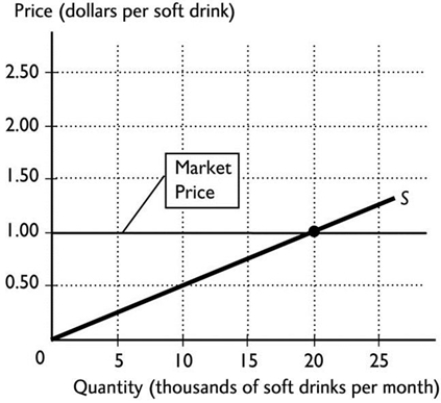 -The figure above shows the supply curve for soft drink. The market price is $1.00 per soft drink. The producer surplus from all the soft drinks sold is
-The figure above shows the supply curve for soft drink. The market price is $1.00 per soft drink. The producer surplus from all the soft drinks sold is
A) $1.00.
B) $0.00.
C) $15.00.
D) $20.00.
E) None of the above answers is correct.
Correct Answer

verified
Correct Answer
verified
Multiple Choice
The marginal benefit of the first hotdog consumed is ________ the marginal benefit of the fifth hotdog consumed.
A) the inverse of
B) equal to
C) equal to 5 times
D) greater than
E) less than
Correct Answer

verified
Correct Answer
verified
Multiple Choice
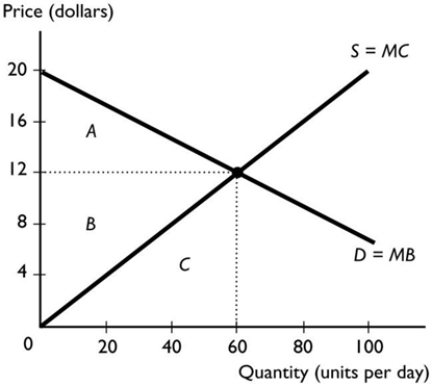 -In the figure above, if the market is at equilibrium, then the total consumer surplus equals the area ________ and the total producer surplus equals the area ________.
-In the figure above, if the market is at equilibrium, then the total consumer surplus equals the area ________ and the total producer surplus equals the area ________.
A) A + B; C
B) A; C
C) C; B
D) A; B
E) B; C
Correct Answer

verified
Correct Answer
verified
Multiple Choice
If the difference between the marginal benefit and the marginal cost of a good is as large as possible,
A) more of the good should be produced.
B) allocative efficiency has been attained.
C) resources are being used with maximum efficiency.
D) resources would create more value producing other goods and hence the production of this good should be decreased.
E) Both answers A and D are correct.
Correct Answer

verified
Correct Answer
verified
Multiple Choice
Samantha was willing to pay $10 for a hamburger because she was hungry but she only paid $2.50. What is the marginal benefit Samantha gained from the hamburger?
A) $2.50
B) $10.00
C) $12.50
D) $7.50
E) None of the above answers is correct.
Correct Answer

verified
Correct Answer
verified
Multiple Choice
Suppose the price of a scooter is $200 and Zoe is willing to pay $250. Zoe's
A) consumer surplus from that scooter is $200.
B) marginal benefit from that scooter is $100.
C) consumer surplus from that scooter is $250.
D) consumer surplus from that scooter is $50.
E) consumer surplus from that scooter is $150.
Correct Answer

verified
Correct Answer
verified
Multiple Choice
Marginal benefit is the benefit that a person receives from consuming
A) all of the possible units of a good or service that can be consumed.
B) one more unit of a good or service.
C) only goods and services that are free.
D) one more unit of a good, and is equal to the cost of producing the unit of the good.
E) a good or service until the person has grown tired of it.
Correct Answer

verified
Correct Answer
verified
Multiple Choice
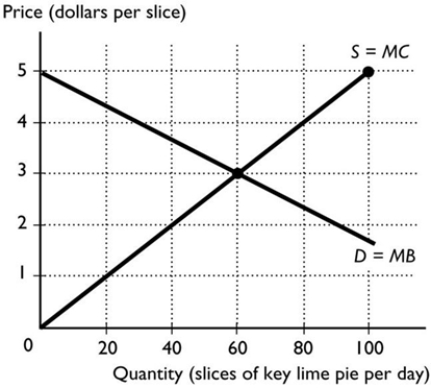 -The figure above represents the competitive market for slices of key lime pie. If the production is 80 slices per day, the cost of the 80th slice is
-The figure above represents the competitive market for slices of key lime pie. If the production is 80 slices per day, the cost of the 80th slice is
A) less than anyone is willing to pay for it.
B) more than anyone is willing to pay for it.
C) equal to what someone is willing to pay for it.
D) equal to the deadweight loss from the 80th slice.
E) indeterminate.
Correct Answer

verified
Correct Answer
verified
Multiple Choice
A monopoly is
A) a firm that has control of a market because it is the only seller.
B) a cost of producing a good or service.
C) a firm that faces intense competition.
D) a firm that creates enormous external costs.
E) the single buyer of some good or service.
Correct Answer

verified
Correct Answer
verified
Multiple Choice
The organisers of the Australian Open randomly draw a few people from hundreds of applicants to compete in the junior section of the championship. The method of allocation for the opportunity to participate in competition is ________, and the method of allocation for determining the winner of the competition is ________.
A) contest; command
B) first-come, first-served; lottery
C) contest; lottery
D) lottery; contest
E) lottery; first-come, first-served
Correct Answer

verified
Correct Answer
verified
Multiple Choice
When efficiency is attained, the sum of the total amount of consumer surplus and producer surplus is
A) undefined.
B) equal to the deadweight loss.
C) equal to zero.
D) maximised.
E) minimised.
Correct Answer

verified
Correct Answer
verified
Multiple Choice
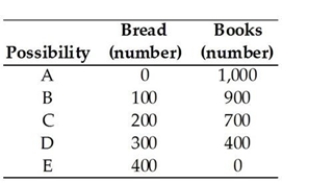 -The table above shows the production possibilities for an economy. When the economy produces a combination of 900 books and 50 loaves of bread,
-The table above shows the production possibilities for an economy. When the economy produces a combination of 900 books and 50 loaves of bread,
A) production efficiency is not achieved.
B) allocative and production efficiency are both achieved.
C) production efficiency is not achieved but allocative efficiency might be achieved.
D) production efficiency occurs because resources are not overused.
E) allocative efficiency is achieved because both goods are produced.
Correct Answer

verified
Correct Answer
verified
Multiple Choice
A point on the demand curve shows the
A) maximum price that people are willing to pay for another unit of a good.
B) consumer surplus a person gains from consuming a unit of a good.
C) dollars' worth of other goods that people must sacrifice to consume another unit of the good.
D) minimum price that people are willing to pay for another unit of a good.
E) marginal benefit minus the consumer surplus from consuming another unit of a good.
Correct Answer

verified
Correct Answer
verified
Multiple Choice
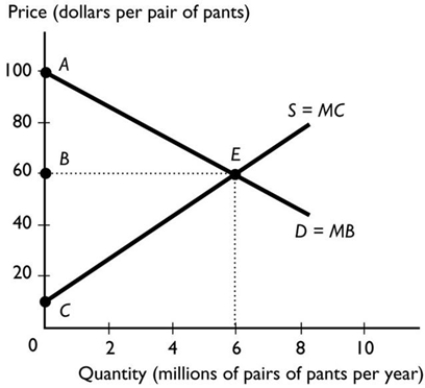 -Which of the following occurs when a market is efficient?
-Which of the following occurs when a market is efficient?
A) Production costs equal total benefit.
B) Producers earn the highest income possible.
C) Every consumer has all of the good or service he or she wants.
D) Scarce resources are used to produce the goods and services that people value most highly.
E) Consumer surplus equals producer surplus.
Correct Answer

verified
Correct Answer
verified
Multiple Choice
A demand curve can be interpreted as
A) an average benefit curve.
B) a marginal cost curve.
C) a marginal benefit curve.
D) a total benefit curve.
E) None of the above answers is correct.
Correct Answer

verified
Correct Answer
verified
Multiple Choice
Suppose Dan is willing to pay a maximum of $3,000 for a piano, but finds one he can buy for $2,500. Dan's consumer surplus from this piano is
A) $5,500.
B) $2,500.
C) $3,000.
D) $500.
E) zero because he buys the piano.
Correct Answer

verified
Correct Answer
verified
Showing 101 - 120 of 130
Related Exams